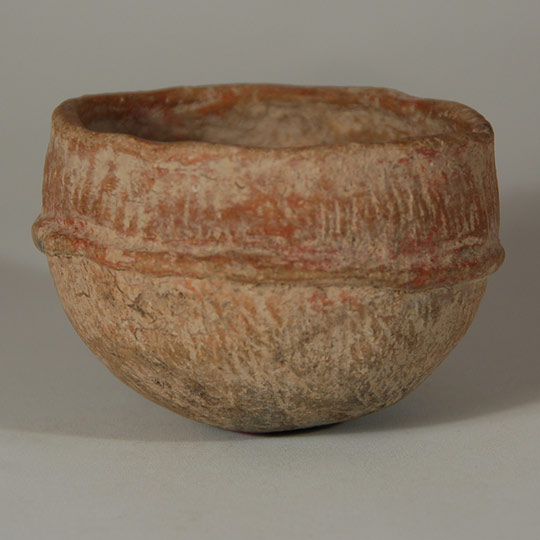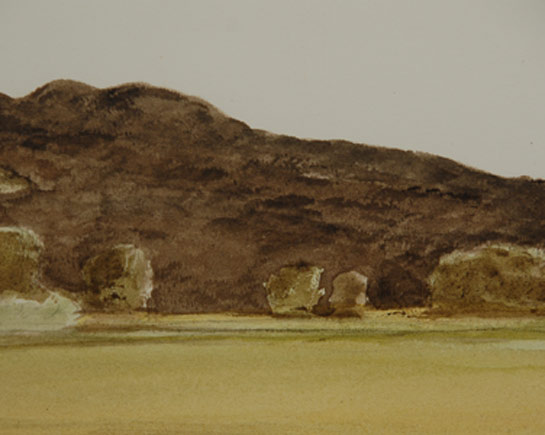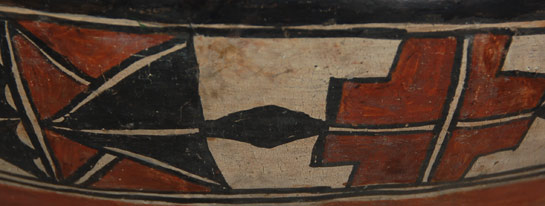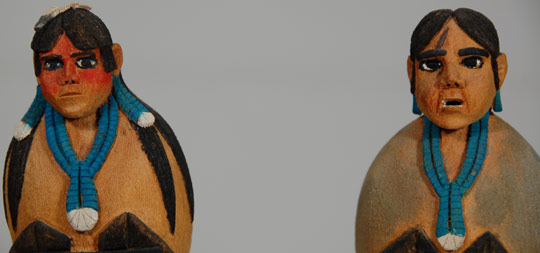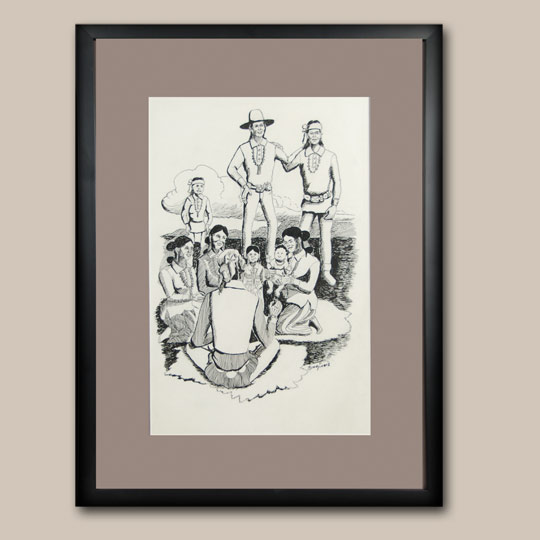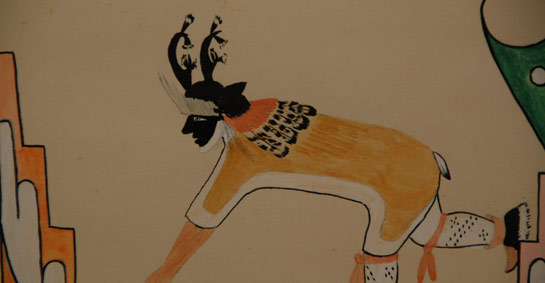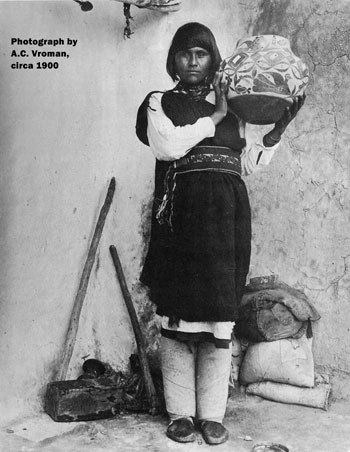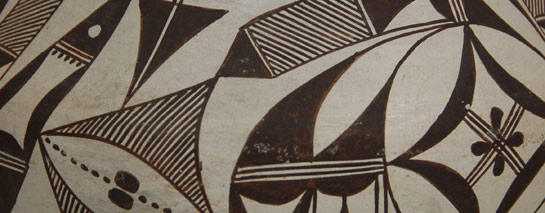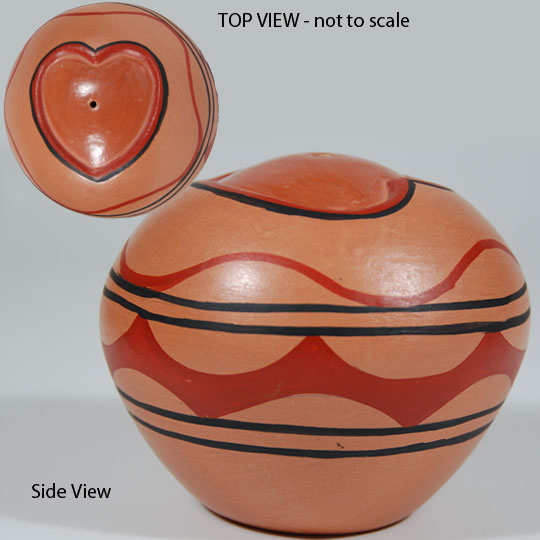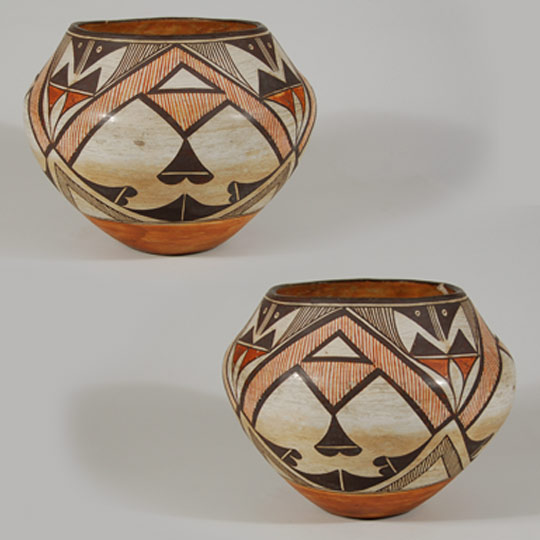Title: Original Painting “Summer Pasture”
Jackson Morley Hensley is a native New Mexican, having been born in Portales. After a brief stint in New York City from 1959 to 1965, where he studied at the National Academy of Design, he returned to Taos, New Mexico, where he now lives and operates the Hensley Art Gallery.
The artist is a landscapist but does not believe in producing photographically accurate paintings. He stated that if that is what one wanted, then one should use a camera. The subjects of Hensley's images vary widely, but there is one element that appears in almost all of them. If you look closely and long enough, you will see something in the painting that suggests a kind of doorway, a secret passage to another world, the inner world of the soul. Hensley himself notes that while his paintings are outwardly about landscapes or people, they are really about his own thoughts and perceptions, his own view of the world.
Tradition, originality and integrity have been the cornerstone of Hensley's high standards in art. Ideology has kept him focused on the quality of his work. His own life and times are what he paints. Thoughts are put down in visual images, altering as life changes with each new day. Reflecting moments, a way of life, the very struggles that affect the work itself and the goodness of man and nature are his artistic statement; because of these qualities his art has become timeless and enduring. These Taos years were very good for Jackson; his self-isolation served him well in creating works of unsurpassed beauty and vitality.
![]() The painting is signed in lower right but not dated. It has been framed using five layers of matboard and a wood gold-tone frame. The framing is possibly original to the painting.
The painting is signed in lower right but not dated. It has been framed using five layers of matboard and a wood gold-tone frame. The framing is possibly original to the painting.
Condition: appears to be in original condition but has not been examined out of the frame.
Provenance: from an art collector in Albuquerque
References: the biographical information above has been excerpted from the Hensley Art Gallery website.
Title: Original Painting "Summer Pasture"
Artist: Jackson Morey Hensley (1940- )
Category: Paintings
Origin: European-American Artists
Medium: watercolor
Size: 7-7/8" x 15-1/8" image; 16-3/4" x 24-1/4" framed
Item # C3346A
Title: Zuni Polychrome Dough Bowl
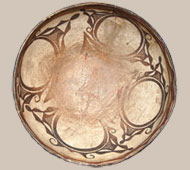 The majority of Zuni dough bowls seem to be 14 inches or less in diameter. Rarely do we see ones larger. That seems to be the standard for most of the ones from Zuni Pueblo. This one, however, is 16 inches in diameter.
The majority of Zuni dough bowls seem to be 14 inches or less in diameter. Rarely do we see ones larger. That seems to be the standard for most of the ones from Zuni Pueblo. This one, however, is 16 inches in diameter.
It dates to the last quarter of the nineteenth century. The paste materials are typically Zuni; white and chunky in texture with the centuries old temper material of ground pottery shards. The use of old shards for temper evidences the regard of the pueblo peoples for the old works made by their predecessors. To add these remnants to the new work is a sign of respect.
The rim of the bowl is slightly indented from the exterior and has a distinctive inward curve on the interior, imparting a graceful shape to the bowl. The flexure of the interior of the rim flexes is a feature that seems to be standard on Zuni bowls.
The bowl is slipped in traditional fashion with cream-colored clay, over which is painted the design in mineral and vegetal paints. The underbody is slipped in black, a tradition starting in the mid-1860s and continued to today. The exterior is decorated with traditional Zuni volutes that are an early portrayal of the Rainbird.
The interior decoration begins with a brown rim below which is a wave-like element encircling the bowl that is painted red and outlined in brown. Below this are two wide parallel framing lines with a ceremonial break. Traditional Zuni volute design Rainbird elements fill the interior of the bowl down to the bottom, which then has a red element that appears as a four-pointed star.
During a burglary of the Anthony residence in the 1990s, this bowl was taken along with everything else. When the entire collection was recovered a week later, a section of this bowl had been broken out. Fortunately it was recovered as well. The broken piece was professionally replaced.
Collection Provenance: Edna Norton, who used to work in the pottery room of The Covered Wagon in Albuquerque
Title: Zuni Polychrome Dough Bowl
Potter Unknown
Category: Historic
Origin: Zuni Pueblo
Medium: Native Materials
Size: 8" deep x 16" diameter
Item # C2750A
Title: Polychrome San Ildefonso Pueblo Interior & Exterior Decorated Bowl
This is a turn-of-the-century polychrome bowl from San Ildefonso Pueblo that is totally slipped inside and outside with traditional Cochiti Pueblo rag-wiped white slip. The interior is decorated in a continuous chain of cloud forms, which are pendant from the lower of two parallel framing lines just below the rim.
The exterior design is an array of different elements. There are crosses, triangles, clouds, diamonds and kiva-step elements, all arranged in a two-inch-wide band encircling the upper body of the bowl. The design band is enclosed within framing lines above and below. A black rim and a wide red band under the painted area complete the design. There has been some professional conservation and restoration.
Provenance: This Polychrome Interior & Exterior Decorated Bowl was shown in the exhibit BOWLS: A Pueblo Necessity December 15, 2006 until December 31, 2006 presented at adobe gallery Santa fe.
Title: Polychrome San Ildefonso Pueblo Interior & Exterior Decorated Bowl
Potter Unknown
Category: Historic
Origin: San Ildefonso Pueblo
Medium: Native Clay
Size: 5-1/2" deep x 14" diameter
Item # 24658
Biography: Tommy Edward Montoya ( -2009) Than Ts'áy Tas
 Adobe Gallery had a long relationship with Tommy Edward Montoya. We featured him as one of our primary artists at the Albuquerque gallery for a number of years. He was a wonderful person and an outstanding artist.
Adobe Gallery had a long relationship with Tommy Edward Montoya. We featured him as one of our primary artists at the Albuquerque gallery for a number of years. He was a wonderful person and an outstanding artist.
Montoya was born at San Juan Pueblo (now Ohkay Owingeh Pueblo) in the family home on the edge of the plaza. His father passed away while Tommy was very young so his mother, originally from Nambe Pueblo, raised him herself. Montoya attended the Santa Fe Indian School and the Institute of American Indian Arts in Santa Fe. He continued on to get his BFA and MFA degrees at California colleges. After returning to the pueblo from California, Montoya took a job as technical illustrator and photographer at Los Alamos National Labs. He pursued his art in the evenings. Once his reputation was established and his commissions increased, he quit his job at Los Alamos and pursued his art career full time.
Ohkay Owingeh is the largest, most northerly, and the most geographically isolated of the six Tewa villages. It is known as one of the pueblos where ritual and political matters continue to be strictly observed. Living and working in this environment, Montoya developed two independent sides of his art: figurative studies of traditional Tewa ritual; and his more cerebral, purely abstract studies of color and form. His popular figurative works, such as this one, brim with vitality and action. His strong asymmetric compositions come to life as if one were witnessing a ceremonial function at the pueblo rather than viewing a piece of art.
Subject: Original Oil Painting of a Pueblo Katsina Dance
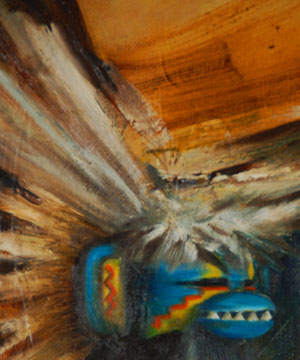 Adobe Gallery had a long relationship with Tommy Edward Montoya. We featured him as one of our primary artists at the Albuquerque gallery for a number of years. He was a wonderful person and an outstanding artist. It is a pleasure to have one of his paintings available again. It brings back our thoughts of Montoya.
Adobe Gallery had a long relationship with Tommy Edward Montoya. We featured him as one of our primary artists at the Albuquerque gallery for a number of years. He was a wonderful person and an outstanding artist. It is a pleasure to have one of his paintings available again. It brings back our thoughts of Montoya.
Montoya was born at San Juan Pueblo (now Ohkay Owingeh Pueblo) in the family home on the edge of the plaza. His father passed away while Tommy was very young so his mother, originally from Nambe Pueblo, raised him herself. Montoya attended the Santa Fe Indian School and the Institute of American Indian Arts in Santa Fe. He continued on to get his BFA and MFA degrees at California colleges. After returning to the pueblo from California, Montoya took a job as technical illustrator and photographer at Los Alamos National Labs. He pursued his art in the evenings. Once his reputation was established and his commissions increased, he quit his job at Los Alamos and pursued his art career full time.
Ohkay Owingeh is the largest, most northerly, and the most geographically isolated of the six Tewa villages. It is known as one of the pueblos where ritual and political matters continue to be strictly observed. Living and working in this environment, Montoya developed two independent sides of his art: figurative studies of traditional Tewa ritual; and his more cerebral, purely abstract studies of color and form. His popular figurative works, such as this one, brim with vitality and action. His strong asymmetric compositions come to life as if one were witnessing a ceremonial function at the pueblo rather than viewing a piece of art.
 This painting of a katsina dance quite possibly features the Sakwahote Katsina, a Hopi Katsina that may have been inspired from a Plains-type warrior, based on the feather headdress, a dance at Hopi that Montoya could have witnessed. If one were to let one's imagination take over while viewing this painting, there would come faint sounds of softly padded and cadenced dance steps of this katsina. Montoya's paintings retain the spirit of Native ceremony and evoke an active participation of the viewer in the scene.
This painting of a katsina dance quite possibly features the Sakwahote Katsina, a Hopi Katsina that may have been inspired from a Plains-type warrior, based on the feather headdress, a dance at Hopi that Montoya could have witnessed. If one were to let one's imagination take over while viewing this painting, there would come faint sounds of softly padded and cadenced dance steps of this katsina. Montoya's paintings retain the spirit of Native ceremony and evoke an active participation of the viewer in the scene.
The painting is signed in lower left with Montoya's Tewa name Than Ts'áy Tas and dated on verso 1975.
Condition: the painting is in original condition
Provenance: the painting was completed in 1975 and sold by the artist to a family in Albuquerque from whom we just acquired it. It has recently been re-framed.
Subject: Original Oil Painting of a Pueblo Katsina Dance
Artist: Tommy Edward Montoya (d.17 August 2009)
Category: Paintings
Origin: Ohkay Owingeh Pueblo (San Juan)
Medium: oil on canvas board
Size: 23-1/2" x 17-1/2" image; 31-1/4" x 25-1/8" framed
Item # C3269A
Subject: Original Painting “Great Spirit Let My Corn Grow” by Quincy Tahoma
"One of the most dynamic, imaginative, and gifted of Southwest Indian Artists."—Clara Lee Tanner, 1973.
Quincy Tahoma attended the Santa Fe Indian School for four years, from 1936-1940, entering in the seventh grade. He was a student at the same time as Harrison Begay, Pablita Velarde, Geronima Montoya, Andy Tsihnahjinnie, and Gerald Nailor, and studied under the tutelage of Dorothy Dunn at The Studio.
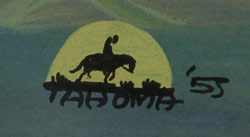 When World War II broke out, he attempted to join the service but an arm that he broke when a youngster, that was never successfully corrected, caused him to be rejected. He stayed in Santa Fe while his friends served in the military. This bothered him to some extent.
When World War II broke out, he attempted to join the service but an arm that he broke when a youngster, that was never successfully corrected, caused him to be rejected. He stayed in Santa Fe while his friends served in the military. This bothered him to some extent.
Tahoma displayed a wide variety of styles in his paintings. He had a "quiet" period, a "peaceful" period and a "violent period." His quiet and peaceful periods were early and late in his career, with his violent period predominating for most of his art life.
Tahoma painted the proud Diné in everyday life on the reservation where he had grown up to the time of leaving for the Santa Fe Indian School at about age 12 or 13. This painting of a Diné man praying for rain for his corn is one very good example of his quiet or peaceful period paintings.
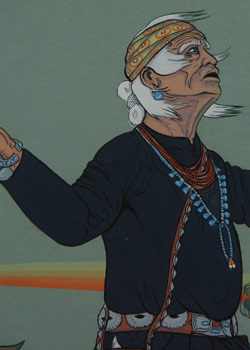 In this painting, Tahoma used harmonious and rich colors in clean-cut and graceful lines, with impeccable draftsmanship. Take note of the burgundy and purple colors of the rock. He was meticulous in his research for subject matter—clothing, landscape, horse features, etc. He was known to paint rather rapidly, but the process of painting was preceded by much thought and research of the subject he had chosen.
In this painting, Tahoma used harmonious and rich colors in clean-cut and graceful lines, with impeccable draftsmanship. Take note of the burgundy and purple colors of the rock. He was meticulous in his research for subject matter—clothing, landscape, horse features, etc. He was known to paint rather rapidly, but the process of painting was preceded by much thought and research of the subject he had chosen.
Tahoma developed a unique signature for his paintings. In the lower right corner of each painting, he drew a cartouche or small painting reflecting what happened next, following the scene in the present painting. He called this the next chapter. In this painting the cartouche shows the farmer riding away on his horse, having made his plea for rain. The painting is dated 1953. It is published in the Quincy Tahoma book on page 131.
Condition: original condition
Provenance: from the collection of the Adler family of Santa Fe
Recommended Reading: Quincy Tahoma, The Life and Legacy of a Navajo Artist by Charnell Havens and Vera Marie Badertscher.
Subject: Original Painting "Great Spirit Let My Corn Grow"
Artist: Quincy Tahoma 1917-1956 Water Edge
Category: Paintings
Origin: Diné - Navajo Nation
Medium: casein
Size: 17-3/4" x 11-5/8" image; 25-3/4" x 19-5/8" framed
Item # C3348
Title: Navajo (Diné) Folk Art Carving “Spider Woman” pair of rattles
Marvin Jim was born in 1966 and raised in a small rural community near Chinle, Arizona-traditional Navajo sheep and goat country. As a child, he made his own toys-trucks and people-carved from wood because there were no commercial toys available. In 1993, he married Grace Begay who said she grew up in an artistic family of weavers, wood carvers and basket makers.
It was Grace Begay who encouraged her husband to put his carving talents into making folk art objects. Jim has become one of the most innovative of the Navajo folk art artists in that he truly creates new items based on his heritage.
This pair of rattles represents the mythological Navajo legend of Spider Woman who is believed to have taught the Navajo women how to weave textiles. Before weavers sit down at the loom, they often rub their hands in spider webs to absorb the wisdom and skill of Spider Woman.
Each of these rattles was made by hollowing out a cottonwood root and carving the exterior to represent the figures. Objects were placed on the interior to provide the rattle. Jim carved the pair of rattles and his wife painted them.
One of the rattles shows Spider Woman with a handful of traditional weaving tools and the other rattle shows her holding a completed Navajo rug. A 6-1/4" x 6-1/4" block of wood has been drilled with two holes for displaying the rattles in an upright position.
Condition: original condition
Provenance: from the collection of Jan and Chuck Rosenak. Published in Navajo Folk Art by Chuck and Jan Rosenak. 1994, page 132.
Recommended Reading: Navajo Folk Art by Chuck and Jan Rosenak.
Title: Navajo (Diné) Folk Art Carving "Spider Woman"
Artists: Marvin Jim & Grace Begay
Category: Other Items
Origin: Diné - Navajo Nation
Medium: wood, paint - pair of rattles
Size: 14" tall each; plus 1-1/2" height of base
Item # C3347A
Title: Diné (Navajo) Painting of a Navajo Family
Clara Lee Tanner expressed that Andrew Tsihnahjinnie was one of the most versatile of all Southwestern Indian artists. Perhaps it was his World War II stint in the Marines while stationed in the Pacific Theater that led to his versatility of style. His Pacific tour exposed him to Japanese and Chinese art which apparently had an effect on his works for a time after the war, but eventually he reverted back to his traditional Navajo style of painting. He progressed through many moods, solidifying a style momentarily, and then turning to something new and utterly different, but his subject matter continued to center around Navajo life and activity.

Tsihnahjinnie has portrayed a scene often enacted on the Navajo Reservation. Perhaps the grandfather figure with his back to the viewer is instructing family members or telling them a story. The happy expressions on the listener's faces would make one believe it is a happy or funny story.
The painting is framed using all acid-free materials and a black wood frame. It is signed in lower right but not dated.
Condition: Original condition
Provenance: from the Balcomb family collection
Recommended Reading: Southwest Indian Painting: a Changing Art by Clara Lee Tanner
Title: Diné (Navajo) Painting of a Navajo Family
Artist: Andrew Tsihnahjinnie (1916-2000)
Category: Paintings
Origin: Diné - Navajo Nation
Medium: Watercolor
Size: 14-1/4" x 9-1/4" image-unframed
Item # C3083C
Biography: Andrew Tsihnahjinnie (1916-2000)
 Andrew Van Tsihnahjinnie (1916-2000) was one of the most versatile of all Southwestern Indian artists. He went through many moods, solidifying a style momentarily then turning to something new and utterly different. His subject matter stayed faithful to his heritage even as his style changed. He was chameleon-like in his ability to change and adapt. He is recognized as one of the finest of 20th Century Navajo artists.
Andrew Van Tsihnahjinnie (1916-2000) was one of the most versatile of all Southwestern Indian artists. He went through many moods, solidifying a style momentarily then turning to something new and utterly different. His subject matter stayed faithful to his heritage even as his style changed. He was chameleon-like in his ability to change and adapt. He is recognized as one of the finest of 20th Century Navajo artists.
Andy Tsihnahjinnie was born near Chinle, Arizona in 1916. He attended elementary school at the Indian School at Fort Apache, but ran away and returned back to the reservation. He then attended school in Santa Fe and became a student of Dorothy Dunn at the Santa Fe Indian School. He was an avid student and was known to have stayed in the studio painting until forced to return to the dormitory. Following his graduation he went to work as an illustrator for the Indian Service.
Tsihnahjinnie's best work is his portrayal of Navajo life and ceremonies. He is known for his attention to detail in paintings. This painting reflects a night dance of Navajo Yei Dancers. The Yei impersonate the Deity Yeibichai of the Diné. The Diné are a spiritual people and everything in their life is a reflection of their beliefs. This dance is performed at the end of a nine-day ceremony and is the public dance following the non-public portion of the previous days.
Over the period of his career, Tsihnahjinnie signed his name in several spellings. For example: A. Tsinajinnie is just one way we have seen it.
Subject: San Ildefonso Original Painting of an Antelope Dancer
José Angela Aguilar, sometimes known as Joe Aguilar, was the son of Susana Aguilar-a well-known potter-and is known to have painted pottery for his mom. He was the husband of Rosalie Simbola Aguilar, originally from Picuris Pueblo and also a potter, for whom he also painted pottery. He was an exceptional painter. Kenneth Chapman included him on a list of fifteen men who painted pottery at San Ildefonso before 1940. His son, Alfred Aguilar, said that his father formed pots, as well as painting them.
![]() There is no mention of him in either Clara Lee Tanner's book or in Dorothy Dunn's book as a painter of paintings; however, there are other references that indicate he was. Snodgrass, in her book, stated "The artist has been actively engaged in art and related subjects since 1944. In 1949, he began painting experiments in new directions." His new direction was the influence of another painter, Joe Herrera, son of Tonita Pena. Seymour stated that in 1987, Aguilar was working in the California aerospace industry doing technical drawings and only an occasional painting for friends.
There is no mention of him in either Clara Lee Tanner's book or in Dorothy Dunn's book as a painter of paintings; however, there are other references that indicate he was. Snodgrass, in her book, stated "The artist has been actively engaged in art and related subjects since 1944. In 1949, he began painting experiments in new directions." His new direction was the influence of another painter, Joe Herrera, son of Tonita Pena. Seymour stated that in 1987, Aguilar was working in the California aerospace industry doing technical drawings and only an occasional painting for friends.
This painting of a San Ildefonso Antelope Dancer is quite possibly an early one by the artist. It is interesting that the artist placed the left foot and left stick that represents the animal's leg, below the ground plane. It is signed Joe A Aguilar but there is no date. The painting is double matted with acid-free materials and framed in a period wood frame.
Condition: In very god condition with two what may be water spots in lower left directly under the abstract plant design.
References:
Tanner, Clara Lee. Southwest Indian Painting, a Changing Art 1957.
Dunn, Dorothy. American Indian Painting of the Southwest and Plains Areas 1968.
Stewart, Kathryn. Portfolio II Eleven American Indian Artists 1988.
Seymour, Tryntje Van Ness. When the Rainbow Touches Down 1988
Snodgrass, Jeanne O. American Indian Painters: A Biographical Directory 1968.
Title: San Ildefonso Original Painting of an Antelope Dancer
Artist: José Angela Aguilar (1898-1965)
Category: Paintings
Origin: San Ildefonso Pueblo
Medium: watercolor
Size: 10-1/2" x 13-1/2" image; 14" x 18" framed
Item # 25594
Title: Navajo Woman Holding Baby in Cradleboard
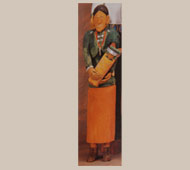 In the 1990s, images of Johnson Antonio's dolls began to appear in newspapers and magazines across the country, and he has received favorable reviews wherever his art has been shown. The Rosenaks stated that when they first met Antonio in 1985, he was driving a horse-drawn wagon. Through sales of his carvings, he soon bought a blue shag-carpeted Chevy van, large enough for his family of eight children.
In the 1990s, images of Johnson Antonio's dolls began to appear in newspapers and magazines across the country, and he has received favorable reviews wherever his art has been shown. The Rosenaks stated that when they first met Antonio in 1985, he was driving a horse-drawn wagon. Through sales of his carvings, he soon bought a blue shag-carpeted Chevy van, large enough for his family of eight children.
The Rosenaks say that he is the most successful of the Navajo carvers and an important role model for younger artists. Antonio is from the northwestern corner of New Mexico called the Bisti. Following high school, he went to work for the Union Pacific Railroad. He said "They picked me up in a bus at the trading post, and took me off to lay steel. It was hard work, and when the laying was done in the fall, they'd take me home again. I'd collect unemployment till they'd come for me in the spring." In 1974, Antonio quit the railroad job and returned home to heard sheep and goats.
In 1982 or 1983, Antonio picked up some cottonwood in a wash near Farmington, took it home and just started carving. This was the beginning of a new career.
This carving is typical of the style of his work. His carvings are generally tall, lean and round figures that one would expect from a tree limb or tree root. This female figure is composed from a single piece of wood for the entire body except perhaps the arms were added at the shoulder. The baby in the cradleboard was carved separately and placed in her arms.
Condition: very good condition
Provenance: from the collection of Jan and Chuck Rosenak. Published in Navajo Folk Art by Chuck and Jan Rosenak. 1994, page 47.
Recommended Reading: Navajo Folk Art by Chuck and Jan Rosenak.
Title: Navajo Woman Holding Baby in Cradleboard [SOLD]
Artist: Johnson Antonio (1931-present)
Category: Other Items
Origin: Diné - Navajo Nation
Medium: wood, paint, metal
Size: 18" tall
Item # C3347G
Title: Cochiti Pueblo Female Dancer Figurine
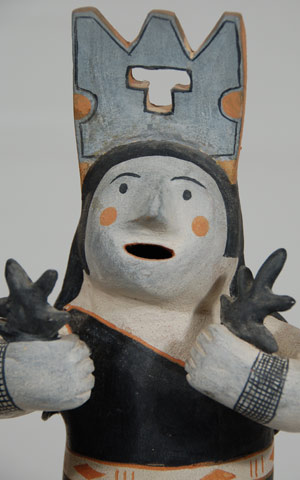 Females of the pueblo participate with the male dancers during the fall and winter animal dances which are a plea for rain and for bountiful crops as well as an abundance of animals for food. Generally, buffalo, deer, antelope, and ram are portrayed together at a dance in the plaza. The female participants dance along with the males, whereas the males impersonate animals, the females impersonate themselves.
Females of the pueblo participate with the male dancers during the fall and winter animal dances which are a plea for rain and for bountiful crops as well as an abundance of animals for food. Generally, buffalo, deer, antelope, and ram are portrayed together at a dance in the plaza. The female participants dance along with the males, whereas the males impersonate animals, the females impersonate themselves.
The female dancers wear the traditional pueblo dress that rises above one shoulder and below the other shoulder. It is cinched at the waist with a woven belt. They wear a wooden tablet on their head which is called a tableta, the Spanish word for tablet. It is interesting that the male dancers wear moccasins and the female dance bare footed. In their hands, they carry evergreen boughs during these fall dances.
Louis Naranjo has presented this female figure in the traditional manner of dress and action. Her long black hair flows down her back, she wears a tableta on her head and in her hands are representations of evergreen boughs. She is barefooted. The figurine is signed in pencil Louis Naranjo Cochiti. Although the figurine will stand unassisted, it has been provided with a Plexiglas pedestal and wire support that provides more security. The stand adds another inch to the overall height of the figure.
Condition: original condition.
Provenance: from the collection of Chuck and Jan Rosenak, renowned collectors and authors of Navajo Folk Art.
Recommended Reading: There is an excellent article on Louis and Virginia Naranjo in Indians of New Mexico, edited by Richard C. Sandoval and Ree Sheck. Published by New Mexico Magazine, Santa Fe, 1990. ISBN 0-937206-16-4. It may be available from the publisher.
Title: Cochiti Pueblo Female Dancer Figurine
Artist / Potter: Louis Naranjo (1932-1997)
Category: Figurines
Origin: Cochiti Pueblo
Medium: clay, pigment
Size: 15-1/2" tall + 1" pedestal
Item # 25601
Title: Cochiti Pueblo Male Buffalo Dancer Figurine
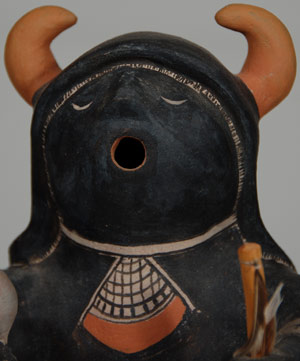 Animal dances at the pueblos are a plea for rain and for bountiful crops as well as an abundance of animals for food. Generally, buffalo, deer, antelope, and rams are portrayed together at a dance in the plaza. It is one of the most often seen dances in the fall and winter.
Animal dances at the pueblos are a plea for rain and for bountiful crops as well as an abundance of animals for food. Generally, buffalo, deer, antelope, and rams are portrayed together at a dance in the plaza. It is one of the most often seen dances in the fall and winter.
Here, Louis Naranjo has made an excellent likeness of a Buffalo Dancer. On his head he is wearing a buffalo skin with horns. The back of the head piece is decorated with a floral element and feathers. Around his body he is wearing a dance kilt. The kilt has a traditional Zia Pueblo Sun image; an image selected 100 years ago as the image for the New Mexico state flag. Tin cones are painted as fringe on the kilt and a belt ties around the waist.
The body of the dancer has been painted to resemble the darkness of the buffalo. In his right hand he carries a drumbeater and in his left a prayer stick. A shell necklace, moccasins, leggings and jewelry on both wrists complete the decoration. The sculpting of the figurine is excellent and the painting is exquisite.
Although the figurine will stand unassisted, it has been provided with a Plexiglas pedestal and wire support that provides more security. The stand adds another ¾-inch to the overall height of the figure. The figurine is signed Louis Naranjo Nov. 14, 1987 Cochiti, N.M. on the underside of the feet.
Condition: original condition.
Provenance: from the collection of Chuck and Jan Rosenak, renowned collectors and authors of Navajo Folk Art.
Recommended Reading: There is an excellent article on Louis and Virginia Naranjo in Indians of New Mexico, edited by Richard C. Sandoval and Ree Sheck. Published by New Mexico Magazine, Santa Fe, 1990. ISBN 0-937206-16-4. It may be available from the publisher.
Title: Cochiti Pueblo Male Buffalo Dancer Figurine
Artist / Potter: Louis Naranjo (1932-1997)
Category: Figurines
Origin: Cochiti Pueblo
Medium: clay, pigment
Size: 13-7/8" tall + ¾" pedestal
Item # 25600
Biography: Mary Histia (1881-1973)
Mary Histia, is recognized as certainly the finest Acoma potter of the early 20th century. According to Batkin, she traveled to Washington DC and became popular as an unofficial potter to President Roosevelt. Her pottery soon decorated many government offices.
Histia deserves to be classed as a Modernist. Her art is old, yet alive and dynamic-an expression of a continuing vigor. She did not confine her art to a mere repetition of her previous work, nor did she resort to meaningless geometric designs, but she continually experimented and added to her repertoire. Her designs are at once classic and modern.
Title: Acoma Pueblo Black-on-white Jar by Mary Histia
Mary Histia deserves to be classed as a Modernist. Her art is old, yet alive and dynamic, an expression of a continuing vigor. She did not confine her art to a mere repetition of her previous work, nor did she resort to meaningless geometric designs, but she continually experimented and added to her repertoire. Her designs are at once classic and modern.
Her vessel shapes, too, are not always following the mainstream. This jar is an exaggerated form of a standard olla shape. The low shoulder and long graceful neck provided her with a large canvas for placing a design. This jar was made late in the career of the artist, about a dozen years before she passed away, yet the workmanship is that of a talented artist.
The execution of the painted design is exquisite, as only Mary Histia capably produced. Each design element is precise and was painted with a sure hand. If one were to examine the design carefully it then becomes obvious that all the designs are bird related. There are pointed black beaks with white "eyes" and black tipped feathers. The layout, when viewed directly looking at the black diamond, gives the illusion of a whirling object with the four components comprising bird designs.
The jar is signed on the underside Made by Mary A. Histia, Acoma Sky City, New Mexico. It is not known how early Histia began signing pottery; perhaps it was as early as the 1930s or a little later.
Condition: very good condition
Provenance: from the collection of a California resident whose husband purchased it from the artist in the 1960s at Acoma Pueblo.
Recommended Reading: Acoma and Laguna Pottery by Rick Dillingham
Title: Acoma Pueblo Black-on-white Jar by Mary Histia
Artist / Potter: Mary Histia (1881-1973)
Category: Contemporary
Origin: Acoma Pueblo
Medium: clay, pigment
Size: 8-1/2" tall x 7-1/4" diameter
Item # C3344
Valentine's Day Special: Jemez Pueblo Pottery Jar with Heart Design
The potter carved into the top center of this jar, a beautifully shaped heart, which is stone polished slip, and outlined it in deep red with a further outline of black. The design on the mid-body is a traditional design seen on Zia dough bowls. I have not been able to find a reference to the potter but perhaps she had connections to Zia Pueblo prior to moving to Jemez, possibly as a result of marriage. At any rate, she is a fine potter. The jar is signed with the potter's name and 2/14/88. Perhaps it was a Valentine gift to Mrs. Rust, the current owner.
Condition: original condition
Provenance: from the collection of Katherine H. Rust
Title: Valentine's Special: Jemez Pueblo Pottery Jar with Heart Design
Artist / Potter: Charlotte Toya
Origin: Jemez Pueblo
Medium: clay, pigments
Size: 3-7/8” tall x 4-5/8” diameter
Valentine's Day Special: Acoma Pueblo Polychrome Jar with Zuni Designs
Designs on pueblo pottery were influenced by many outside sources starting as early at the mid-1800s. Floral elements, birds, deer, and other designs could easily have been influenced by Spanish colcha designs as well as pottery designs from Mexico. It was also evident that potters borrowed designs from pueblos other than their own.
The heartline deer design was first seen at Zuni Pueblo, but later appeared on pottery from Acoma, Laguna and Zia Pueblos. Intermarriage between pueblos also contributed to designs appearing where they never appeared before.
This Acoma jar is completely covered with Zuni design elements. The orange/red fine lines in the A-frame areas are most typically Zuni in origin. The entire layout of the design is typical of Zuni arrangement, yet the pot is from Acoma Pueblo. It is not as thin-walled as Acoma pottery generally is so it is possible that a transplant potter from Zuni or another pueblo moved to Acoma and practiced the art of making Acoma pottery but had not yet achieved the expertise of creating thin walls.
The jar is a beautiful example of a well formed vessel and a beautifully arranged design. It is in excellent condition.
Title: Acoma Pueblo Polychrome Jar with Zuni Designs
Category: Contemporary
Origin: Acoma Pueblo
Medium: Native Materials
Size: 6-3/4" tall x 9" diameter
Item # C3064B
Valentine's Day Special: Laguna Pueblo 16-piece Pottery Nacimiento
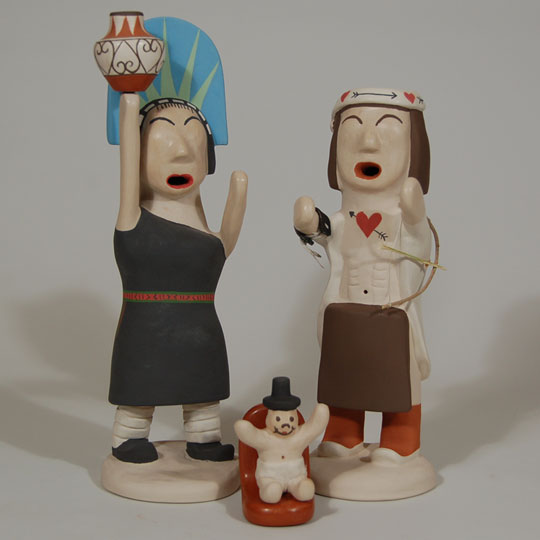
When Max Early delivered this nacimiento to us, he explained that he was interested in creating a set that could and would be displayed year round. To do this, he included figurines from various seasons of the year. The Saint Nick is appropriate for the Christmas season and then could be put away the remainder of the year. Saint Patrick, famous for ridding Ireland of snakes, would be appropriate for Saint Patrick's Day, then stored for the remainder of the year. The Grim Reaper, with his pumpkin and black cat, is perfect for Halloween, and then stored away if desired.
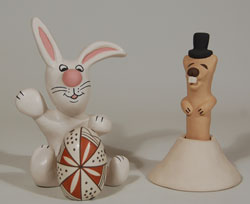 The Virgin Mary is presented as the Statue of Liberty, Baby Jesus as the New Year Baby, and Joseph with the display of a heart for Valentine. There is an Easter Bunny and Easter egg. The eagle represents the Fourth of July and the turkey for Thanksgiving. The penguin and Rudolph are thrown in for fun as is the ground hog for Ground Hog Day.
The Virgin Mary is presented as the Statue of Liberty, Baby Jesus as the New Year Baby, and Joseph with the display of a heart for Valentine. There is an Easter Bunny and Easter egg. The eagle represents the Fourth of July and the turkey for Thanksgiving. The penguin and Rudolph are thrown in for fun as is the ground hog for Ground Hog Day.
To cap it all off, Max wrote a poem on a white slab of clay that accompanies the nacimiento. The group is referred to as a nacimiento but really is more representative of all American holidays. It is a charming set created from a fertile mind.
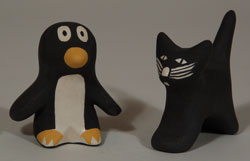 Max Early was born into the Turkey Clan of his mother and Bear Clan of his father at Laguna Pueblo. He grew up with his grandparents. During his early teenage years, he painted some of his grandmother's pottery. He refined his technique to a personal touch, while maintaining traditional Laguna design symbols and compositions.
Max Early was born into the Turkey Clan of his mother and Bear Clan of his father at Laguna Pueblo. He grew up with his grandparents. During his early teenage years, he painted some of his grandmother's pottery. He refined his technique to a personal touch, while maintaining traditional Laguna design symbols and compositions.
Since 1994, Early has continued to be honored as a top prize-winning artist at Santa Fe Indian Market. At the same time, he has pursued his higher education degree at the University of New Mexico, leaving little time for making pottery. He hopes to pursue a career as a poet and proudly told us that his first book of poetry will be published in the next few months.
Condition: new
Provenance: from the artist
Recommended Reading: Nacimientos - Nativity Scenes by Southwest Indian Artisans by Doris Monthan, et al.
Title: Laguna Pueblo 16-piece Pottery Nacimiento
Artist / Potter: Max Early (b.1963)
Category: Figurines
Origin: Laguna Pueblo
Medium: clay, pigments
Size: 9-3/4" tallest ; 16-piece set
Item # C3331
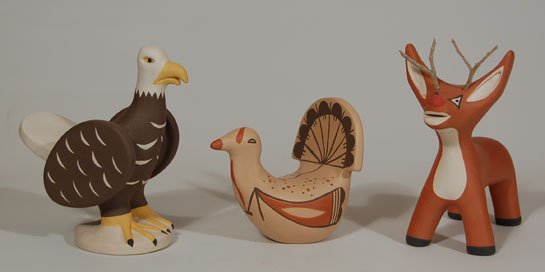
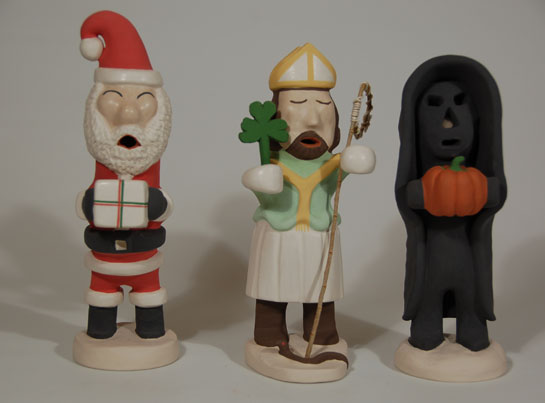
Valentine's Day Special: Four-color Polychrome Zia Olla with Hearts
There is precedence for picturing animals on pueblo pottery-namely the Mimbres, in the 1100s, featured insects, fish, birds, and large and small animals primarily on the interior of bowls. There was then a large time span before animals appeared again, this time in the late-1800s on Zuni Pueblo pottery in the form of heartline deer figures. It could be that this inspired potters to paint deer on Zia pottery. According to Harlow and Lanmon, the earliest documented Zia pottery with deer designs is 1870s.
This jar is probably from the first quarter of the 20th century. The design is divided into four quadrants, each of which contains basically the same design. There is an orange colored deer outlined in black. The deer is housed in an arch similar to that seen on Zuni pottery. There is what may be a rainbow arch above the deer house, flowers inside with the deer and black outlined hearts separating the four quadrants. Each heart is filled with parallel vertical black lines.
According to Harlow and Lanmon, there is a jar with orange deer in the Laboratory of Anthropology in Santa Fe purchased in 1929 and two similar ones in the Denver Art Museum collected in 1927. It is quite possible that the same potter made all four of these jars with orange-colored deer. Zia elders identified two possible potters either of whom could have made all four-Isabel Medina Toribio or Virginia Salas.
Condition: structurally in excellent condition with exfoliation of slip around the rim and mid-body due from extensive use as a water jar.
Provenance: from the collection of an Albuquerque gentleman
Recommended Reading: The Pottery of Zia Pueblo by Francis H. Harlow and Dwight P. Lanmon
Title: Four-color Polychrome Olla from Zia Pueblo
Potter Unknown
Category: Historic
Origin: Zia Pueblo
Medium: clay, pigment
Size: 9-3/4" tall x 11-3/8" diameter
Item # C3328B
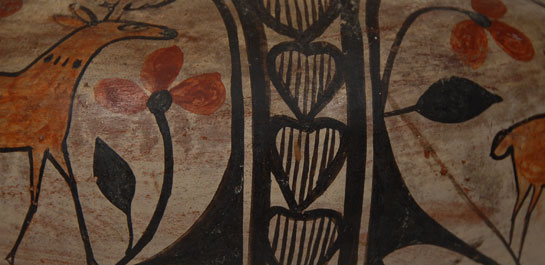
Title: Small Undecorated Utilitarian Bowl
This small bowl almost has the feel of a stone metate or vessel for processing medication. It is heavy in weight, appears to have been incised with lines over the entire exterior surface and painted with red pigment. A single row of clay wraps around the vessel on the exterior. It is so tempting to assign a function to it as possibly having been a paint jar or a medicine vessel, but there certainly is no way to do so. It is what it was, whatever that might have been.
Condition: very good condition, with some unidentified residue on the interior.
Provenance: from the collection of Katherine H. Rust
Recommended Reading: Secrets of Casas Grandes, edited by Melissa S. Powell
Title: Small Undecorated Utilitarian Bowl
Potter Unknown
Category: Pre-Columbian or Prehistoric
Origin: Mexico
Medium: clay
Size: 2-1/2" deep x 3-1/2" diameter
Item # C3309G
